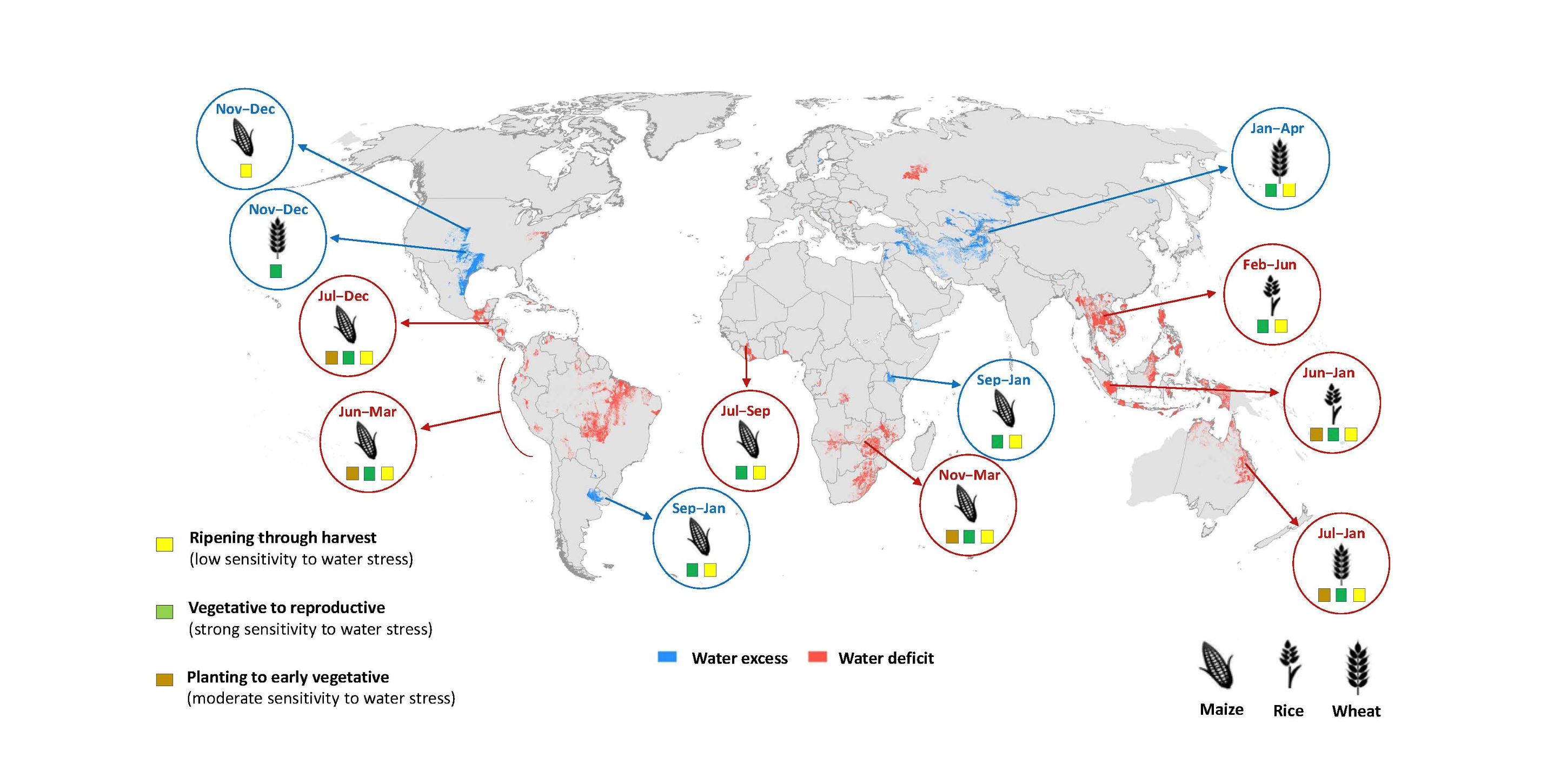Threat of El Niño looms, FAO prepares anticipatory actions with Members and partners
Weather reversal pattern points to higher drought risks in southern Africa and Central America and Far East Asia

Agricultural areas with high correlation between dry and wet conditions related to El Niño.
©FAO
Given the record number of people facing acute food insecurity, the Food and Agriculture Organization of the United Nations (FAO) is scrutinizing the areas in the globe that are especially vulnerable to El Niño and how anticipatory action could be taken to mitigate its risks.
According to a new report by FAO’s Global Information and Early Warning Systems of the Markets and Trade Division, the Office of Climate Change, Biodiversity and Environment and the Office of Emergencies and Resilience, Southern Africa, Central America and the Caribbean and parts of Asia are of particular concern, as a number of countries in these regions already face high levels of acute food insecurity and key cropping seasons fall under the typical El Niño weather patterns of drier conditions. Northern areas of South America are also at risk to potential dryness, while Australia normally experiences suppressed rainfall.
“Early warnings mean that we have to take early and anticipatory action, and we will support our Members in these efforts, to the full extent resources allow,” said Rein Paulsen, head of FAO’s Office for Emergencies and Resilience.
In the wake of the El Niño episode of 2015 and 2016, which affected more than 60 million people in around 23 countries, FAO has worked assiduously with its Members – including many of those where food security is likely to be impacted by the coming El Niño – and other UN agencies to establish anticipatory action plans and protocols. Standard operating procedures have been crafted to expedite timely interventions such as setting up community seed stores, assessing strategic food reserves and bolstering animal health surveillance campaigns.
For example, FAO has developed Anticipatory Action protocols for drought in Burkina Faso, Chad, Niger, southern Madagascar, Malawi, Zimbabwe, the Philippines, Pakistan, and in Central America, and is ready to act early, in coordination with governments and partners, should the forecasts materialize.
Entering unknown territory
Given the most recent forecasts that have raised the likelihood of an El Niño event occuring from June onwards, FAO is already setting in motion initial preparations to support affected countries.
“Forecasts at this point are clear but inevitably can only be put forth with low confidence due to their low power during the May-June-July period,” explained Oscar Rojas, FAO Agrometeorologist.
El Niño events typically occurs every two to seven years, with La Niña episodes and neutral conditions filling the years in-between. Catalyzed by a warming of Pacific Ocean waters, El Niño has a major influence on temperature and precipitation patterns over many parts of the world, driving extreme weather events including drought, flooding and storms.
While El Niño events and impacts are never alike, the broadly typical patterns enhance predictable regional consequences. FAO’s approach has been to map changes in vegetation conditions across the globe’s croplands and combine this analysis with crop calendars to better understand how rainfall deficits may affect production – the effects of water stress vary throughout a crop’s life cycle. This approach helps to identify areas at higher risk - those where dry conditions impact the entire crop cycle - and guide the type of interventions that should be implemented.
Under the Standard Operating Procedures for Early Action to El Niño/La Niña Episodes by the UN Interagency Standing Committee (IASC), anticipatory action initiatives advance in step with the likelihood that an El Niño event is brewing. FAO, OCHA and the WMO together with other partners are monitoring the situation to determine the countries at highest risk later in the year.
Mapping the risks
While rain will be a welcome relief to farmers in Argentina and Near East Asia, El Niño can also cause severe flooding, which can harm agriculture and increase the risk of disease. That’s a particular risk FAO has examined in relation to East Africa, which has faced four years of extreme rainfall deficits and where recovery will at any rate take a long time even if rainfall finally returns.
Australia, Brazil and South Africa, all major cereal producers and exporters, are among the countries at risk of dry conditions, as are a host of other countries in Central and West Africa, Southeast Asia and the Caribbean.
The inverse risk of excessive rainfall holds for exporters such as Argentina, Turkey and the United States of America, as well as for countries in Central Asia.
El Niño typically raises the global average temperature and was associated with the record high registered in 2016, when various carbon-releasing calamities occurred, including forest and peatland fires in Indonesia and billions of trees decimated by drought in the Amazon.
Contact
Christopher Emsden FAO News and Media (Rome) (+39) 06 570 53291 [email protected]
FAO News and Media (+39) 06 570 53625 [email protected]
